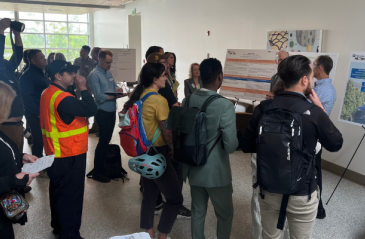
The information barriers holding back climate action and how to break them

@johnjnay of @skoposlabs has an algorithm that predicts the fate of Congressional bills
Share articleWhile thousands of bills are introduced in Congress, only about 4% become law
Share articleAlgorithms can help citizens better understand what Congress is doing, says @johnjnay
Share articleWe put our vision for government into practice through learning partner projects that align with our values and help reimagine government so that it works for everyone.
In politics, it's fair to say that accurate predictions are easier said than done. Or are they?
While few saw Brexit and the election of Donald Trump coming, unpredictability does not cast its shadow across the entire political arena. Not any more. Take the US Congress for example. Its hallowed halls and respect for long-held tradition might seem to be an unlikely place for artificial intelligence (AI) to take root. But take root it has, thanks to the work of John Nay of Skopos Labs, who has developed an algorithm that predicts which congressional bills will make their way through both chambers and which will become law.
“Each Congress has thousands of different pieces of legislation,” he points out. “But unless you're really plugged into what's going on, it is really hard to know which are relevant and which might have a chance of being enacted. That's where we come in.”
Skopos Labs may be based in New York City, but its sights are firmly trained on Capitol Hill. It was set up by Nay - a computer scientist by training - and two cofounder law professors while he was a PhD student at Vanderbilt University in Tennessee. It aims to help policymakers and citizens alike keep track of the multitude of bills that wind their way (with vastly varying degrees of success) through the different legislative stages of both the House of Representatives and the Senate. While thousands of bills are introduced, only about 4% become law - and Nay's algorithm helps identify which are likely to emerge, or not, into the light of real-world impact.
“We are principally focused on legislation,” he explains. “We did this primarily because it is really high impact and, because there is so much legislation, it is hard to sift through it all. And we also did it because a lot of the data we need for getting started with this is publicly available, so we were able to get up and running relatively quickly, compared to other areas of the law where the data is much harder to get.”
Although other algorithms have predicted whether a bill will survive the committee stage or proceed to be voted on in full session, Nay and his team look at the outcome of the legislation as well as providing explanations about their predictions.
“So, if we say a bill has a 20% chance, we would say why it has a 20% chance and identify the factors that are increasing or decreasing its chances,” he says. “Providing the analysis behind a prediction essentially allows you to set out what policymakers should or shouldn't do to make it more likely for the legislation to be enacted.”
Interestingly, he says that the algorithm has helped showcase the fact that many bills are actually very similar when it comes to the actual text of the document. “One specific example would be to look at one bill against the other bills that are pending and the ones from the past two Congresses that are very similar in terms of their actual policy content,” he explains.
“This involves searching across hundreds of thousands of pages of text. But what we can do involves looking at the full text of each bill and comparing it to all the other ones. This allows you to understand the context. Personally, I was very surprised when I kept seeing the same content being introduced in Congress after Congress - it's not something that is obvious.”
The accuracy with which Nay can predict the passage of legislation is clearly something that should win the hearts and minds of any AI sceptics. Nay, though, says that such doubters should also be reassured by the fact that - in general - the development of AI remains very much in its infancy. “AI is very useful, but we're still really far away from something like artificial general intelligence - which is where a machine can successfully perform any intellectual task that a human being can,” he points out.
“But where it can make a difference is in a lot of places where it can augment what humans are doing. So, even if the system reveals a predictive probability and the factors which are affecting it, it still takes a human legal expert to determine the legal implications of the legislation. So there is clearly a human in the loop. Essentially, what we are doing is providing another way to strengthen evidence-based decision-making, but the actual decisions and the communication around them are fully human.”
It's already starting to win converts, it transpires. “People who are really in the trenches in DC and part of the legislative process are definitely sceptical about the predictive power,” he concedes. “But what they aren't sceptical about is the ability - to use machine-learning terms - of ‘unsupervised learning'. This is the ability to find clusters of information and organise and synthesise massive amounts of text. The proof that we can do this is already clear for people to see.”
Looking further ahead, Nay expresses the hope that algorithms such as his will help citizens better understand what their elected representatives are doing in each congressional term, as well as making policymakers more accountable to voters. “By the end of each Congress - so every two years - there are about 10,000 bills which are pending,” he points out. “Being able to rank these in order of which are likely to become law will save huge amounts of time and boost transparency as well.”
And he even says that, in time, it could help bridge the partisan divide which has become so deep in recent years. “This is definitely a possibility,” he concludes. “By bringing to light the fact that a lot of the content isn't that different even across Congresses, even when different parties were in control, then I would hope that should certainly help them move in that direction.”
Now that's a result all of us should welcome.
The Centre for Public Impact is investigating the way in which artificial intelligence (AI) can improve outcomes for citizens.
Are you working in government and interested in how AI applies to your practice? Or are you are an AI practitioner who thinks your tools can have an application in government? If so, please get in touch.












